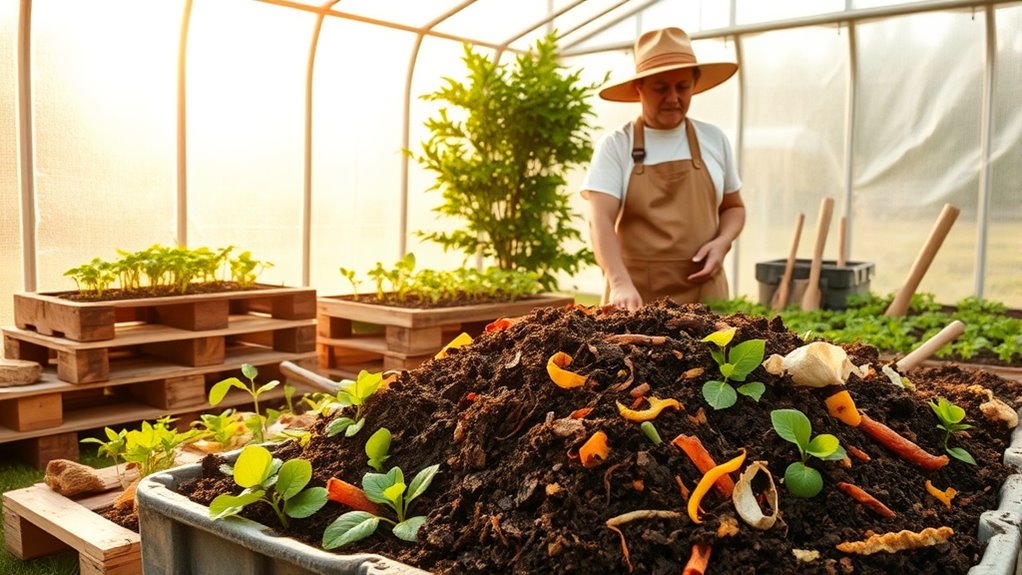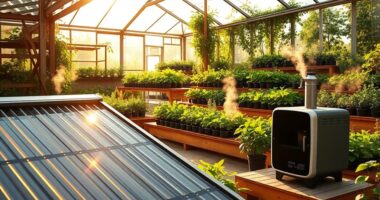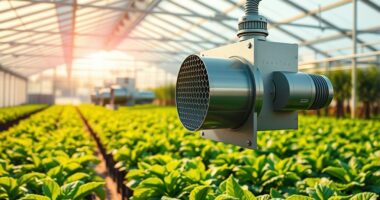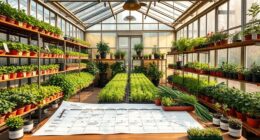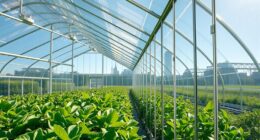In your greenhouse, you can turn organic waste like food scraps, yard debris, and coffee grounds into rich compost that boosts plant health. By selecting a suitable method—such as bins, tumblers, or worm composting—you’ll manage moisture, temperature, and airflow for fast, odor-free decomposition. Proper setup and routine care help create a sustainable, closed-loop system that reduces waste and fertilizes your plants naturally. Keep exploring to discover how to optimize your composting process even further.
Key Takeaways
- Use a controlled environment in the greenhouse to efficiently break down organic waste with microorganisms.
- Select appropriate composting methods (e.g., worm bins, bokashi) based on space and decomposition speed.
- Properly layer greens and browns, maintain moisture, and turn the compost to ensure optimal microbial activity.
- Monitor temperature and moisture levels regularly to prevent odors, pests, and slow decomposition.
- Incorporate finished compost into soil or use as compost tea to naturally enrich plants and support sustainable gardening.
Understanding the Basics of Composting in a Greenhouse
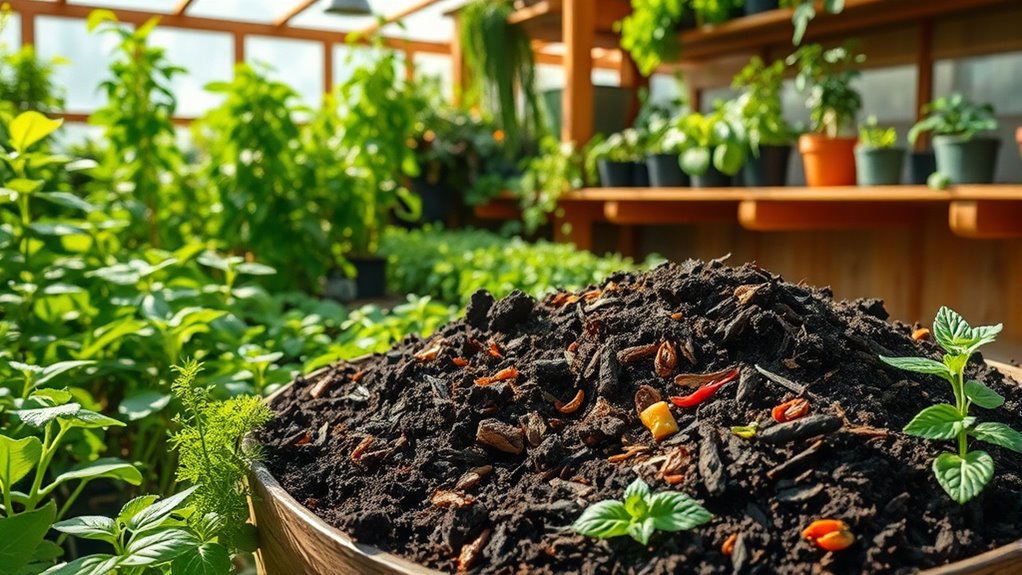
Since a greenhouse provides a controlled environment, understanding how to compost effectively within it can considerably boost your gardening success. Composting relies on microorganisms that break down organic materials, turning waste into rich compost. To keep these composting microorganisms active, maintaining proper compost temperature regulation is essential. In a greenhouse, you can manage temperature more easily than outdoors, ensuring the compost stays warm enough for microorganisms to thrive, especially during cooler months. Consistent warmth speeds up decomposition and prevents odors. Monitoring temperature with a compost thermometer helps you adjust conditions, such as adding green or brown materials or covering the pile. Additionally, incorporating vertical storage solutions can help optimize space for composting areas within your greenhouse. Using climate control systems can further stabilize temperature and moisture levels, promoting efficient composting year-round. Employing temperature regulation techniques tailored to your greenhouse environment can significantly enhance composting efficiency and microbial activity. Furthermore, selecting appropriate composting methods suited for your space can optimize decomposition rates and reduce potential issues. To further support effective composting, understanding the role of microorganisms can help you create ideal conditions for microbial activity.
Choosing the Right Composting Method for Your Space

When selecting a composting method, consider your available space and how much volume you need to process. Different options, like tumblers, bins, or worms, vary in maintenance and odor control. Choosing the right method guarantees your composting fits your greenhouse and keeps it running smoothly. Incorporating community engagement can also provide valuable tips and motivation for maintaining your compost system. Additionally, understanding cost-effective strategies can help you optimize your setup without overspending. For example, selecting the appropriate wicking materials can improve moisture retention and reduce the need for frequent watering, making your composting process more efficient and sustainable. Exploring low light office plants can also contribute to creating a healthier, more inviting environment within your greenhouse. Recognizing common ex-relationship challenges can also inspire innovative solutions to enhance your composting environment.
Space Availability and Size
Choosing the right composting method depends heavily on the space you have available in your greenhouse. If you have limited room, consider compact options like bin composters that utilize vertical space efficiently. Larger areas allow for outdoor or in-ground composting, which requires more space but less maintenance. To help you decide, consider the table below:
| Space Type | Suitable Method | Key Consideration |
|---|---|---|
| Small, confined | Vertical compost bins | Container size, vertical space |
| Medium, moderate | Tumbler or barrel composters | Space for rotation, airflow |
| Large, open | In-ground or heap composting | Space availability, ease of access |
Matching your space to the right method ensures effective composting without overcrowding or inefficiency. Additionally, understanding the composting process can help optimize your setup for faster results. Proper air circulation is essential for maintaining aerobic conditions and speeding up composting.
Composting Method Types
Selecting the right composting method depends on the space you have available in your greenhouse. If you have limited room, worm composting is a great option; it’s compact, efficient, and requires minimal space. You’ll set up a bin with bedding for worms to consume kitchen scraps, producing nutrient-rich castings. Celebrity lifestyle insights can also inspire eco-friendly practices, including sustainable composting methods. For those seeking a faster, odor-free process, bokashi systems are ideal. They use fermentation to break down organic waste quickly in sealed containers, making them perfect for small or enclosed spaces. Indoor composting methods are gaining popularity for their convenience and environmental benefits. Incorporating market trends shows that more gardeners are adopting indoor composting to reduce waste and improve sustainability. Both methods are manageable indoors and don’t require large outdoor areas. Consider your available space, budget, and how quickly you want compost to be ready. Choosing between worm composting and bokashi systems helps you tailor your greenhouse composting to fit your specific needs.
Maintenance and Odor Control
Maintaining your compost system and controlling odors are key to keeping your greenhouse environment clean and efficient. Regularly turning your compost prevents unpleasant smells and accelerates decomposition.
To avoid pest problems, keep compost covers secure and avoid adding meat, dairy, or oily foods. Staying compliant with composting regulations ensures you’re managing waste responsibly and safely. Using appropriate composting methods can further enhance decomposition efficiency and odor control.
Proper aeration reduces odor buildup and discourages pests, making your compost less attractive to unwanted critters. Monitor moisture levels; too much moisture fosters odors, while too little slows decomposition.
Establish a routine to check for any signs of pests or foul smells, and address issues immediately. By preserving your system diligently, you’ll produce rich compost while keeping your greenhouse odor-free and pest-free.
What to Add to Your Compost Bin: Do’s and Don’ts

Knowing what to add to your compost bin is essential for creating healthy, rich compost. You should include fruit scraps like apple peels and banana skins, which provide valuable nutrients.
Including fruit scraps like apple peels and banana skins adds valuable nutrients to your compost.
Yard waste such as grass clippings, leaves, and small branches also help balance the compost and promote aeration. Do add a mix of greens (fruit scraps, fresh plant material) and browns (yard waste, dry leaves) to maintain proper carbon-to-nitrogen ratios. Incorporating proper layering techniques can further enhance decomposition and prevent issues like compaction.
Additionally, incorporating composting best practices such as proper layering and turning can accelerate decomposition and improve compost quality.
Don’t add meat, dairy, or oily foods, as they attract pests and cause odors. Avoid adding diseased plants or invasive weeds, which can spread issues.
Also, steer clear of pet waste, which may carry pathogens. Follow these do’s and don’ts to ensure your compost stays healthy, odor-free, and productive.
Setting Up Your Greenhouse Compost System
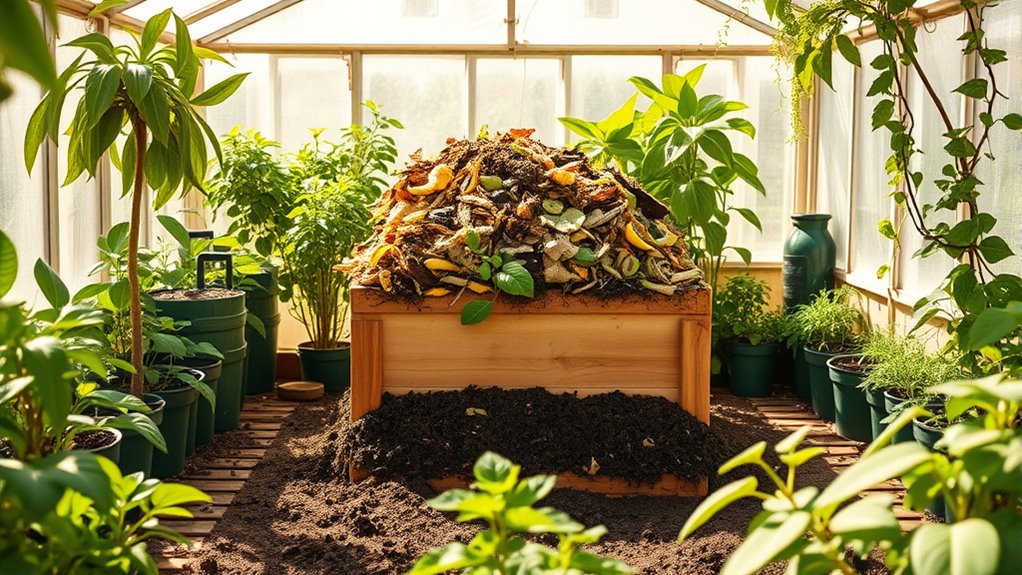
To start your greenhouse compost system, choose a location that stays well-ventilated and easy to access.
Gather your organic materials, like vegetable scraps and yard waste, to guarantee a balanced mix.
Then, build a container system that fits your space and keeps everything contained and manageable.
Choosing the Right Location
Choosing the right location for your greenhouse compost system is essential to guarantee efficient decomposition and easy access. You want a spot that doesn’t disrupt your garden aesthetics and blends smoothly with your greenhouse environment.
Place your compost bin where it’s convenient to add materials and monitor progress without being in the way. Select an area that’s well-drained to prevent water pooling and foul odors.
Keep the compost away from plants vulnerable to pests; a strategic distance minimizes pest attraction and helps with pest prevention. Shade is beneficial, as direct sunlight can dry out compost or cause overheating.
Gathering Compost Materials
Gathering the right materials is the foundation of a successful greenhouse compost system. First, understand common composting myths—such as the idea that composting smells bad or attracts pests. In reality, with proper balance, it’s odor-free and eco-friendly.
Always follow proper composting etiquette: layer greens (fruit and vegetable scraps, coffee grounds) with browns (dry leaves, straw) to maintain airflow and prevent odors. Avoid adding meat, dairy, or oily foods, which can attract pests and disrupt the process.
Collect a variety of suitable materials, ensuring a good mix of nitrogen-rich and carbon-rich items. This diversity speeds up decomposition and creates rich compost.
Building a Container System
Setting up your greenhouse compost system begins with selecting the right container to contain and manage your materials effectively. Your compost bin should suit your space and needs, encouraging active decomposition. A well-designed container allows airflow, moisture control, and easy access for turning compost. Consider your container design carefully to guarantee it promotes efficient composting and minimizes odors. Here’s a table to help you choose:
| Feature | Why It Matters |
|---|---|
| Size | Fits your available space and compost volume |
| Material | Durable, moisture-resistant, easy to clean |
| Ventilation | Promotes oxygen flow for healthy composting |
| Accessibility | Easy to add materials and turn compost |
| Drainage | Prevents excess moisture buildup |
Choosing the right container design inspires confidence and makes composting enjoyable.
Managing Temperature and Moisture for Optimal Composting

To achieve efficient composting in your greenhouse, managing temperature and moisture levels is essential. Proper moisture regulation ensures your compost stays damp but not soaked, promoting microbial activity without causing odors or compaction. Use a moisture meter or squeeze test to check the consistency—aim for a damp sponge.
Temperature control is equally important; it keeps the compost warm enough to accelerate decomposition and kill pathogens. Maintain a temperature between 135°F and 160°F for active composting. Regularly turn the pile to distribute heat evenly and prevent overheating.
Adjust moisture as needed—add water if it’s too dry or dry materials if it’s too wet. By actively managing these factors, you create ideal conditions that turn waste into rich, usable compost efficiently.
Troubleshooting Common Composting Problems
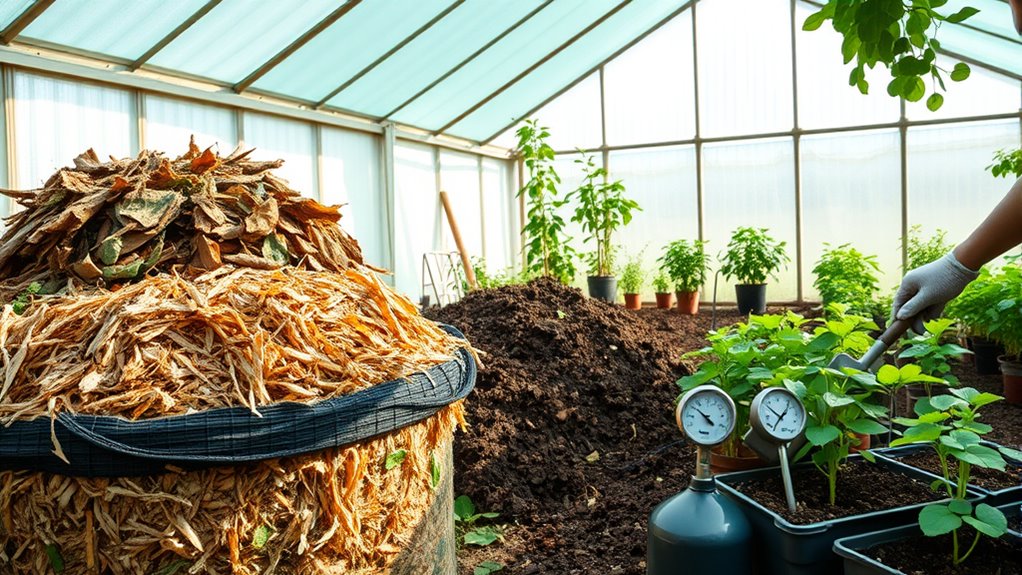
When composting goes wrong, it’s often due to imbalanced conditions that hinder microbial activity. If your compost smells foul, it’s likely too wet or has too many greens, which can attract pests. To prevent this, turn the pile regularly and balance browns and greens properly.
Pests can become a problem if food scraps aren’t buried deep or if composting regulations aren’t followed—some areas restrict composting certain materials. Keep meat, dairy, and oily foods out of your compost to avoid pests and comply with local rules.
If your compost isn’t breaking down, check moisture levels and aerate more often. Monitoring and adjusting these factors helps you troubleshoot common issues, ensuring your compost remains healthy, pest-free, and compliant with regulations.
Incorporating Compost Into Your Greenhouse Plant Care Routine

Incorporating compost into your greenhouse routine starts with understanding the best methods to apply it effectively. You’ll want to choose the right technique to suit your plants and space, ensuring nutrients reach the roots efficiently.
Let’s explore how different composting methods work and how to use compost to boost your plant health.
Composting Methods Explained
There are several effective composting methods you can use to enrich your greenhouse plants, each suited to different space and resource constraints. Worm composting, or vermicomposting, involves using worms to break down organic waste rapidly and produce nutrient-rich castings. It’s ideal for small spaces and indoor setups.
The Bokashi method uses anaerobic fermentation to ferment kitchen scraps in a sealed container, turning waste into compost in just a few weeks. It’s quick, odorless, and suitable for indoor use.
Both methods allow you to recycle kitchen waste efficiently and produce compost with minimal effort. Choosing the right method depends on your available space, waste volume, and time.
Incorporating these techniques into your routine can considerably boost your greenhouse’s productivity and sustainability.
Applying Compost Effectively
To get the most benefit from your compost, you need to apply it properly to your greenhouse plants. Start by mixing worm castings into your soil or potting mix to boost nutrient levels naturally.
You can also create compost teas by steeping compost in water, then using the liquid as a gentle, nutrient-rich spray on your plants.
Spread a thin layer of compost directly on the soil surface to improve aeration and moisture retention.
Be careful not to apply too much at once, which can cause nutrient imbalances.
Regularly incorporate worm castings and compost teas into your routine to promote healthy growth, stronger roots, and better disease resistance.
Consistent application guarantees your plants thrive and your composting efforts pay off.
Benefits of Composting for Greenhouse Plants and Soil Health
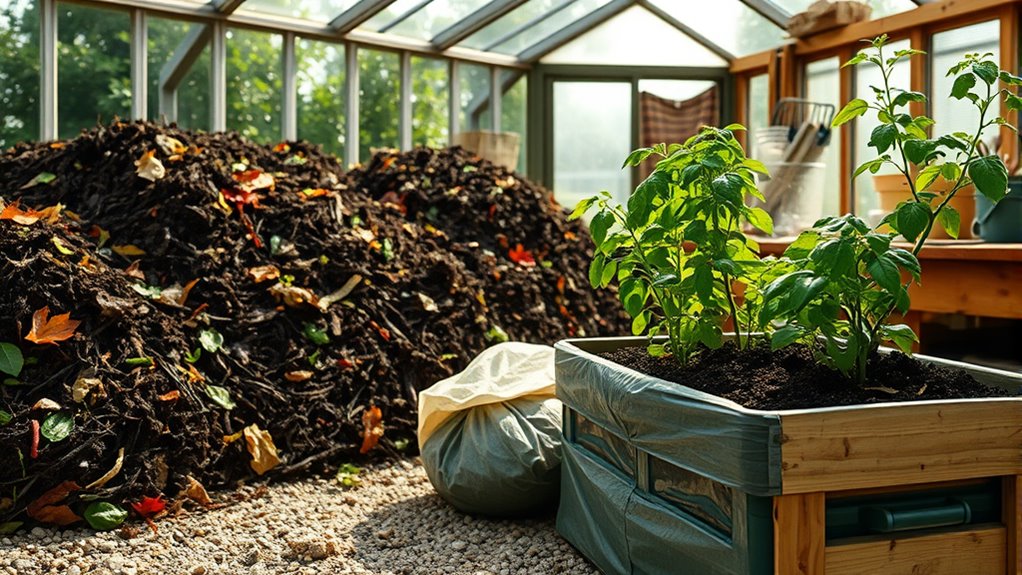
Composting offers numerous benefits for your greenhouse plants and soil health by enriching the soil with essential nutrients. When you use compost tea, you deliver a liquid fertilizer that boosts plant growth and strengthens immunity.
Vermicomposting, which involves earthworms breaking down organic waste, creates nutrient-rich castings that improve soil structure and fertility. These methods help retain moisture, reduce pests, and promote healthy root development.
Regularly applying compost enhances microbial activity, leading to healthier, more resilient plants. Plus, composting minimizes waste and reduces the need for chemical fertilizers, making your greenhouse more sustainable.
Tips for Maintaining a Healthy and Efficient Compost System

Maintaining a healthy and efficient compost system requires regular attention and proper management. Incorporate worm composting to accelerate decomposition and produce nutrient-rich castings that boost your soil.
To keep your system thriving, turn the compost regularly to aerate it and prevent odors. Monitor moisture levels, ensuring the compost stays moist but not waterlogged. Using compost tea is an excellent way to supply your plants with quick nutrients; brew it by steeping compost in water and apply it as a liquid feed.
Avoid adding meat or dairy, which can attract pests. Keep a balanced mix of green and brown materials, and check temperature levels to ensure active decomposition.
With consistent care, your compost system will remain productive, enriching your greenhouse soil and supporting healthy plant growth.
Turning Composting Waste Into a Sustainable Gardening Practice

Transforming composting waste into a sustainable gardening practice not only reduces landfill contributions but also enriches your soil naturally. You can do this through methods like worm composting, which produces nutrient-rich castings perfect for plant growth.
Using compost tea, you can easily nourish your greenhouse plants with a natural liquid fertilizer. Imagine:
- Harvesting worm castings for healthy, vibrant plants
- Brewing compost tea to boost soil microbes
- Recycling kitchen scraps into nutritious compost
- Creating a closed-loop system that minimizes waste
- Enhancing plant growth with minimal chemical inputs
Frequently Asked Questions
How Long Does It Typically Take for Compost to Be Ready in a Greenhouse?
You might wonder how long it takes for compost to be ready in your greenhouse. Usually, compost reaches maturity within 3 to 6 months, depending on factors like temperature monitoring and material type.
Warmer temperatures speed up decomposition, while consistent turning helps. Keep an eye on smell and texture; when it’s dark, crumbly, and earthy, your compost is ready for use.
Patience and proper supervision ensure the best results.
Can I Compost Diseased Plant Material Without Spreading Pathogens?
You can compost diseased plant material safely if you use proper pathogen sterilization techniques. To prevent spreading pathogens, guarantee your compost reaches high temperatures—around 140-160°F—and maintains them for several days.
This process is key to diseased plant management, as it destroys harmful pathogens. Turning and aerating the compost regularly helps maintain heat, making your compost safe for reuse and reducing the risk of disease transmission in your greenhouse.
What Are the Best Tools for Turning and Mixing Compost in a Greenhouse?
Imagine you’re a chef stirring a bubbling pot; your goal is even cooking. For your compost, rotating composters act like a chef’s whisk, making mixing effortless.
Use sturdy mixing tools like pitchforks or compost turners to break up clumps and aerate. These tools help you evenly distribute moisture and microbes, turning waste into rich soil.
With the right tools, you’ll keep your compost healthy and active, just like a master chef.
How Do I Prevent Pests and Rodents From Accessing My Compost Bin?
To prevent pests and rodents from accessing your compost bin, you should focus on pest barriers and rodent proofing techniques.
Make certain your bin has a secure, tightly fitting lid and consider adding hardware cloth or metal mesh around openings.
Keep the area clean, avoid adding meat or dairy, and regularly check for signs of pests.
Proper rodent proofing and pest barriers will help maintain a healthy, pest-free composting environment.
Is It Safe to Use Compost Tea Made From Greenhouse Compost on Edible Plants?
You might wonder if it’s safe to use compost tea from your greenhouse compost on edible plants. Generally, compost tea is safe if you follow proper brewing practices and avoid pathogen concerns.
Use well-aged compost and guarantee the tea is brewed in clean conditions. Avoid applying it during flowering or when plants are stressed.
Properly prepared compost tea provides nutrients without risking contamination, making it a safe application for your edible plants.
Conclusion
So, you’ve now got the secret sauce to turn trash into treasure right in your greenhouse. Who knew that tossing your veggie scraps could actually make your plants happier and your soil richer? Just remember, composting isn’t rocket science—unless you forget to turn it or let it smell like a swamp. Keep it simple, stay consistent, and soon you’ll be a green-thumbed alchemist, transforming waste into gold. Happy composting—your plants (and neighbors) will thank you!
